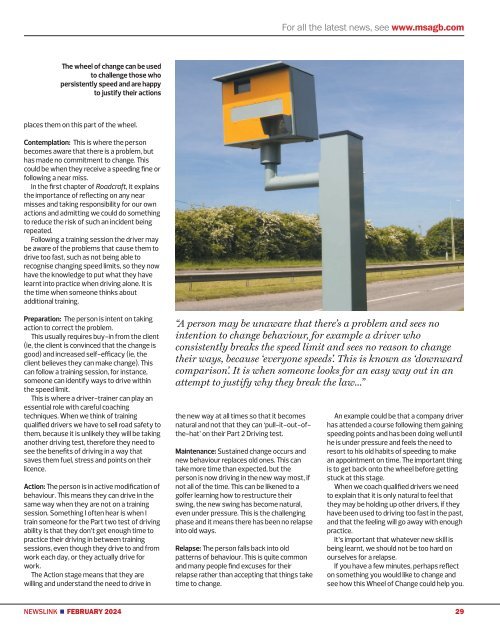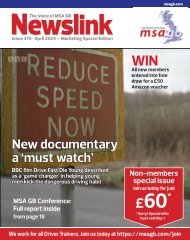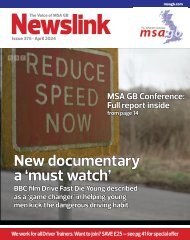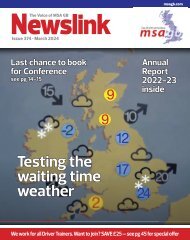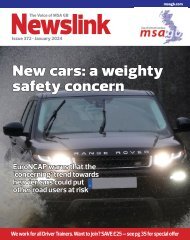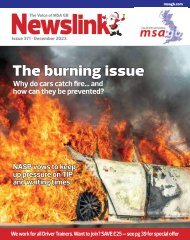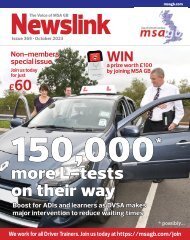Newslink February
Motor Schools Association; driver training and testing; road safety
Motor Schools Association; driver training and testing; road safety
Create successful ePaper yourself
Turn your PDF publications into a flip-book with our unique Google optimized e-Paper software.
For all the latest news, see www.msagb.com<br />
The wheel of change can be used<br />
to challenge those who<br />
persistently speed and are happy<br />
to justify their actions<br />
places them on this part of the wheel.<br />
Contemplation: This is where the person<br />
becomes aware that there is a problem, but<br />
has made no commitment to change. This<br />
could be when they receive a speeding fine or<br />
following a near miss.<br />
In the first chapter of Roadcraft, it explains<br />
the importance of reflecting on any near<br />
misses and taking responsibility for our own<br />
actions and admitting we could do something<br />
to reduce the risk of such an incident being<br />
repeated.<br />
Following a training session the driver may<br />
be aware of the problems that cause them to<br />
drive too fast, such as not being able to<br />
recognise changing speed limits, so they now<br />
have the knowledge to put what they have<br />
learnt into practice when driving alone. It is<br />
the time when someone thinks about<br />
additional training.<br />
Preparation: The person is intent on taking<br />
action to correct the problem.<br />
This usually requires buy-in from the client<br />
(ie, the client is convinced that the change is<br />
good) and increased self-efficacy (ie, the<br />
client believes they can make change). This<br />
can follow a training session, for instance,<br />
someone can identify ways to drive within<br />
the speed limit.<br />
This is where a driver-trainer can play an<br />
essential role with careful coaching<br />
techniques. When we think of training<br />
qualified drivers we have to sell road safety to<br />
them, because it is unlikely they will be taking<br />
another driving test, therefore they need to<br />
see the benefits of driving in a way that<br />
saves them fuel, stress and points on their<br />
licence.<br />
Action: The person is in active modification of<br />
behaviour. This means they can drive in the<br />
same way when they are not on a training<br />
session. Something I often hear is when I<br />
train someone for the Part two test of driving<br />
ability is that they don’t get enough time to<br />
practice their driving in between training<br />
sessions, even though they drive to and from<br />
work each day, or they actually drive for<br />
work.<br />
The Action stage means that they are<br />
willing and understand the need to drive in<br />
“A person may be unaware that there’s a problem and sees no<br />
intention to change behaviour, for example a driver who<br />
consistently breaks the speed limit and sees no reason to change<br />
their ways, because ‘everyone speeds’. This is known as ‘downward<br />
comparison’. It is when someone looks for an easy way out in an<br />
attempt to justify why they break the law...”<br />
the new way at all times so that it becomes<br />
natural and not that they can ‘pull-it-out-ofthe-hat’<br />
on their Part 2 Driving test.<br />
Maintenance: Sustained change occurs and<br />
new behaviour replaces old ones. This can<br />
take more time than expected, but the<br />
person is now driving in the new way most, if<br />
not all of the time. This can be likened to a<br />
golfer learning how to restructure their<br />
swing, the new swing has become natural,<br />
even under pressure. This is the challenging<br />
phase and it means there has been no relapse<br />
into old ways.<br />
Relapse: The person falls back into old<br />
patterns of behaviour. This is quite common<br />
and many people find excuses for their<br />
relapse rather than accepting that things take<br />
time to change.<br />
An example could be that a company driver<br />
has attended a course following them gaining<br />
speeding points and has been doing well until<br />
he is under pressure and feels the need to<br />
resort to his old habits of speeding to make<br />
an appointment on time. The important thing<br />
is to get back onto the wheel before getting<br />
stuck at this stage.<br />
When we coach qualified drivers we need<br />
to explain that it is only natural to feel that<br />
they may be holding up other drivers, if they<br />
have been used to driving too fast in the past,<br />
and that the feeling will go away with enough<br />
practice.<br />
It’s important that whatever new skill is<br />
being learnt, we should not be too hard on<br />
ourselves for a relapse.<br />
If you have a few minutes, perhaps reflect<br />
on something you would like to change and<br />
see how this Wheel of Change could help you.<br />
NEWSLINK n FEBRUARY 2024 29


